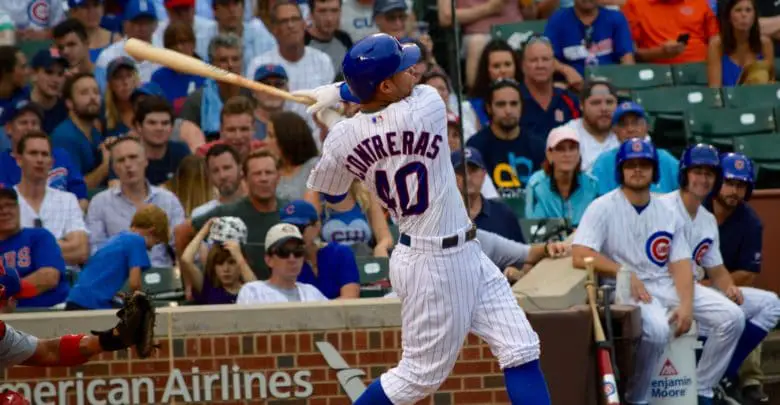
Does Acquisition of Martin Maldonado Signal Increased OF Time for Willson Contreras?
Nothing erases a bad loss like the excitement of a trade. Even acquiring a backup catcher can take the sting out of defeat, and the Cubs made just such a deal by picking up veteran backstop Martin Maldonado from the Royals in exchange for Mike Montgomery following a frustrating loss to the Reds.
Maldonado’s acquisition didn’t occur in a vacuum, of course. Willson Contreras was placed on the 10-day injured list, retroactive to Sunday, because of a heel injury the Cubs worried might be aggravated by playing. But al indications are that this move was not made solely because of an injury, since the Cubs insist Contreras isn’t likely to to be out beyond the minimum 10-day allotment.
Instead, it appears as if the Cubs had been working on the framework of a deal involving Maldonado for some time. That could mean one or more of a few things, all of which revolve around Victor Caratini’s role with the team and all of which have been speculated to some degree since the trade.
- The Cubs intend to deal Caratini for help in some other area(s) and go with Maldonado as the primary backup.
- The Cubs don’t necessarily intend to deal Caratini, but don’t view him as a viable backup catcher for the remainder of the season and could option him.
- The Cubs do will carry all three catchers like they did in 2016.
If they opt for door number three, as I suspect they will, that could mean more time in the outfield for Contreras.
That means carrying three catchers worthy of a spot on a major league roster, as they did with Contreras, David Ross, and Miguel Montero during their championship season. It’s worth looking back on how they managed the situation then for clues on how the rest of 2019 might play out.
Montero and Ross led the way, logging 558.1 and 448.2 innings behind the plate, respectively. Contreras, who didn’t come up until mid-June, accumulated 389.2 innings at catcher. This isn’t really about his catching though, it’s about his play in the outfield.
When not behind the plate, Contreras logged 180.2 innings in left field. That represents by far the most time he’s spent in the outfield in his big league career, comfortably eclipsing the second place total of 32 innings in 2017. He has seen less and less of the outfield over the past two seasons, but that’s because the Cubs’ catching situation has been different. Rather than carrying one or two veterans, they have at times been without a viable backup catcher to shoulder the additional load.
That lack of depth may have contributed to WillCo’s significant slump in the second half of last year. While Caratini has proven himself to be a solid backup with a solid bat and surprisingly good receiving skills, there is still reason to think that Contreras might benefit from further time off from the grind of catching through more regular trips to a corner outfield spot.
Part of the reason it’s been so difficult to get him that reprieve is that the team has hardly been able to afford losing his bat in the lineup. The emergence of Caratini and the addition of Maldonado changes that equation to an extent.
More time in the outfield equates means playing Contreras more often without also subjecting him to the harsh physical demands of catching. While he may need every fifth day or so off while exclusively catching, those days could be cut down if he caught only every two of five or three of five days and spent the rest of his time manning a relatively less taxing corner outfield spot.
That’s not to say the Cubs could or should think that moving him to the outfield would be a surrogate for somewhat regular rest, but such a move could help both keep his body fresh and his bat in the lineup. After all, they’ve done it before.
This is all without getting into the interesting combinations the Cubs could employ with their trio of catchers. Playing Contreras and the solid-hitting Caratini at the same time creates a lineup with more offensive potential than we’ve often seen this year. A lineup with Contreras and Maldonado keeps a premium bat in the lineup while adding the kind of elite framing and defense at the catcher position that the Cubs haven’t had since 2016.
The possibilities are intriguing, to say the least. Every good Cubs team from now until the end of time will be compared to the 2016 squad (which, interestingly enough, won the World Series). But in this particular facet of the team, the comparison makes sense. The possibilities presented by shifting Contreras to the outfield on a more regular basis could present a significant advantage to this Cubs team going forward.
